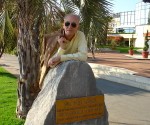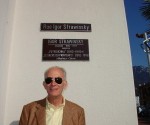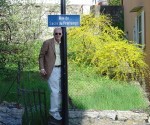by Sedgwick Clark
Juilliard and Joseph—Polisi at 25
Unrelenting rain couldn’t dampen the good cheer inside the Juilliard School’s Peter Jay Sharp Theater on April 26 for a gala honoring its president of 25 years, Joseph Polisi. There have been many changes in that quarter century. The student body is more diverse. There are jazz and historical-performance departments now. The endowment has grown five-fold. Along with the recent renovation of Alice Tully Hall has come a 39,000 square foot addition to the school, including the dance studio, which is visible to passersby on Broadway. And, no one should forget, Polisi was Musical America‘s Educator of the Year for 2005.
This congratulatory evening offered continuing proof, if need be, that the ailments of classical music have nothing to do with talent. The student performances were exhilarating, starting with 15-year-old violinist Sirena Huang and 14-year-old cellist Sarina Zhang, who played the Handel-Halvorsen Passacaglia with humbling assurance and artistry (from memory, incidentally, on four days’ notice). The Juilliard Orchestra played selections, with a number of talented vocalists, from Le Nozze di Figaro. There was world-premiere choreography by Adam Hougland, set to the Andante of Brahms’s Sextet No. 1. Future stars from the Drama department acted selections from Shakespeare, August Wilson, and Tennessee Williams. For a grand finale, the third movement of Rachmaninoff’s finger-busting Piano Concerto No. 3 was negotiated masterfully by 15-year-old Conrad Tao, who was singled out by Harris Goldsmith in the 2008 Musical America as “the most exciting prodigy ever to come my way. His promise is limitless.”
The season is nearly over, but you’ll probably see these young performers’ names on future Juilliard concerts. Most are free, and all contain a brand of commitment and fresh insight that will renew your faith in mankind.
Why We Left Muncie
May 3 was the third time in a year that I’ve run into American composer Jack Beeson. The occasion was the Presentation of the American Music Center’s Awards at which Beeson was receiving the AMC’s Letter of Distinction, given annually since 1964 “to recognize those who have made a significant contribution to the field of contemporary American music.” A year ago, on May 21, 2009, the octogenarian composer received an ASCAP Honor for his 50-year membership in that venerable organization. In between these two awards, I saw him on January 26, when his “Love Song, Arietta and Aria” from his opera The Sweet Bye and Bye was performed at a Juilliard FOCUS! concert.
And why is my running into one of America’s distinguished composers important? Because Beeson, too, was born in and left Muncie, Indiana, to go east for a life in music: to study with Howard Hanson at Eastman and, later, with Béla Bartók in New York City, and then for 50 years to teach at Columbia, where one of his students was MA.com contributor Peter G. Davis. I left to write this blog.
Electrifying Szymanowski and Bartók
Of five concerts I heard last weekend, a pair at Zankel knocked my socks off! The concentration was on Karol Szymanowski (1982-1937), Poland’s leading composer after Chopin. Scriabin, Bartók, and Debussy were strong influences, but at his best—in the two violin concertos, the Third Symphony, the Second Quartet, and several chamber works and songs on these two programs—the music conveys an otherworldly ecstasy quite unlike that of his colleagues. Works by Bartók, Schumann, and Janácek were also performed.
Pianist Piotr Anderszewski was the prime mover here, providing full-blooded, freely expressive playing, always sensitive to the quiet moments. Szymanowski’s Metopes and Janácek’s In the Mists glimmered with color, and Bartók’s brief Three Hungarian Folksongs from Csík sang idiomatically. Anderszewski’s partnering with an extraordinary young Norwegian violinist/violist, Henning Kraggerud, in Szymanowski’s Mythes and Schumann’s Märchenbilder, quite took the breath away; he played with Orpheus at Carnegie earlier this season, but I won’t let another opportunity pass when he’s in town. Another artist new to me was the Polish soprano Iwona Sobotka, whose ravishing singing of Szymanowski’s song cycles Slopiewnie and Songs of a Fairytale Princess bowled the audience over.
Last, but certainly not least, was the Belcea Quartet, which Harris Goldsmith has been raving about to me for some time and I now know why. Their impassioned, slash-and-burn performances of Szymanowski’s two string quartets and Bartók’s First Quartet called to mind the Juilliard Quartet from its 1960s recordings—and better than that, in this repertoire, I can’t say. The Szymanowski Second Quartet, in their hands, sounded like one of the last century’s great quartets and the audience went wild. First violinist Corina Belcea-Fisher’s luxuriant vibrato and sliding was a special treat. The Belcea has recorded the Bartók 6 for EMI (I must get the set).
It’s a shame the Times wasn’t in attendance: Both Szymanowski and these superb performers deserved the imprimatur a review would have conferred.
Pogo = NoNo
David Patrick Stearns’ description, quoted in yesterday’s MusicalAmerica.com, of Ivo Pogorelich’s playing of Chopin’s Piano Concerto No. 2 on tour in Japan with the Philadelphia Orchestra (“the most complete expression of contempt I’ve ever heard”) reminded me of my last encounter with “Pogo,” as he’s known in the trade. It was a Tchaikovsky Piano Concerto No. 1 with the Boston Symphony and Seiji Ozawa at Carnegie Hall in 1996. David’s description of Pogo’s Chopin could well be of the Tchaik’s 23-minute opening movement: “Each new statement of Chopin’s main melody was treated with an increasingly slow graveness, to the point at which Pogorelich was literally stopping the music.” I vowed never to hear him again. And I haven’t.
Russian Stravinsky Festival
Next week: a roundup of the Philharmonic/Gergiev’s Russian Stravinsky Festival.
Looking forward
My week’s scheduled concerts:
5/6 Avery Fisher Hall. New York Philharmonic/Valery Gergiev; Denis Matsuev, piano. Stravinsky: Symphony in C; Capriccio for Piano and Orchestra, Petrushka (1911 version).
5/7 Avery Fisher Hall. New York Philharmonic/Valery Gergiev; Alexei Volodin, piano. Stravinsky: Symphony in Three Movements; Concerto for Piano and Wind Instruments; The Rite of Spring.
5/10 Ensemble ACJW/John Adams; Jeremy Denk, piano. Adams: Son of Chamber Symphony; Stravinsky: Concerto for Piano and Wind Instruments; Andriessen: De Staat.
5/12 Metropolitan Opera. Berg: Lulu.


